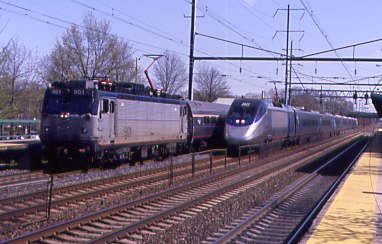
4/18/2006 A 6:15 AM wake-up call started me off for the day. The hotel bill was under the door so I returned the key to the front desk of the Holiday Inn Express, an excellent hotel in which to stay in Philadelphia. I then walked to the Market East SEPTA station, stopping at Dunkin' Donuts along the way, bought a SEPTA Center City ticket and rode the R3 Elwyn train back to 30th Street Station where I sat on the bench in the Grand Hall until the Solari Board showed my track number.
Amtrak Keystone 640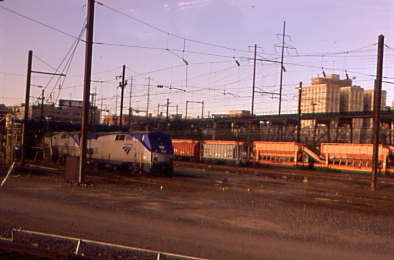
I was welcomed to Keystone Service by the wonderful voice of Conductor Marvin singing "New York, New York!" This was the first time I had ridden a Keystone Service train and was going to Princeton Junction.

The train arrived at Zoo Tower in Philadelphia, which controls this important junction of the Northeast Corridor and the Harrisburg line.

Our train crossed the Schuylkill River.

As the train sped up, I spotted one of Bennett Levin's E8A locomotives at North Philadelphia.

Later we crossed the Delaware River, with the world-famous sign "What Trenton Makes, the World Takes!" We stopped at Trenton, then made the sprint to Princeton Junction, where I detrained for a short ride and to photograph trains. Both of these were new to me.
Princeton Junction, New Jersey
Princeton Junction's origins can be traced back to the United New Jersey Railroad and Canal Company, the predecessor of the Pennsylvania Railroad in the 19th century. The original station was built in 1864, in preparation for Princeton Branch service to begin in 1865. Albert Einstein, who lived at 112 Mercer Street in Princeton, used to enjoy sitting at the station and watching the trains go by. More than once, he employed trains to explain the practical effects of his General Theory of Relativity.


New Jersey Transit Train 3823 bound for Trenton.
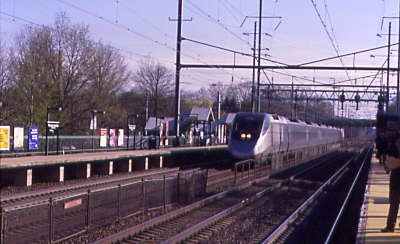

Acela Express 2109 en route from New York to Washington at speed.


New Jersey Transit Trian 3926 bound for New York City.
New Jersey Transit shuttle train to Princeton
I walked from the south end of the east platform down a sidewalk to the station, through a tunnel under the four tracks, then up a hill to the waiting train. I learned that this service is locally called "The Dinky" or the "PJ&B", meaning Princeton Junction and Back. I asked the conductor about getting a ticket and she advised me to ride to Princeton and purchase my ticket there so I boarded car 1326. The tracks made a right turn before heading northwest with a few slight curves. We crossed Stoney Brook with Carnegie Hall to the east before entering the campus of Princeton University then stopped at the stone station located on University Place.

Princeton University, a private Ivy League research university founded in 1746 in Elizabeth as the College of New Jersey. It is the fourth-oldest institution of higher education in the United States and one of the nine colonial colleges chartered before the American Revolution. The institution moved to Newark in 1747 and then to its Mercer County campus in Princeton nine years later. It officially became a university in 1896 and was subsequently renamed Princeton University.


After enjoying the fresh morning air, I returned on the 9:18 AM train for the five minute trip back to Princeton Junction.

A last picture of the Dinky.

New Jersey Transit train 3936 on its way to New York.

Amtrak Keystone Train 642 bound for Harrisburg, Pennsylvania.


Acela Express 2151 going from Boston to Washington.


New Jersey Transit Train 3822 for Trenton.

New Jersey Transit Train 3938, a local on its way to New York.

Amtrak Regional 130 also going to New York.


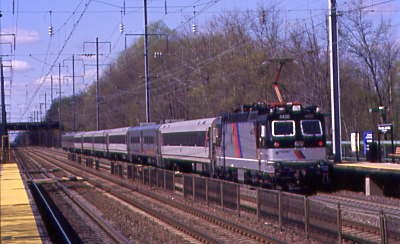
New Jersey Transit Train 3829, a Trenton local.

New Jersey Transit Train 3840, a New York local.

Amtrak Regional 172 from Washington to Boston.

The Princeton shuttle out in the clear.



Amtrak's Pennsylvanian travelling from New York to Pittsburgh.


Acela Express 2153 from Boston to Washington, passing the Pennsylvanian at track speed.
Amtrak Keystone 646

I boarded the last car and chose a rear-facing seat for the trip to New York City.
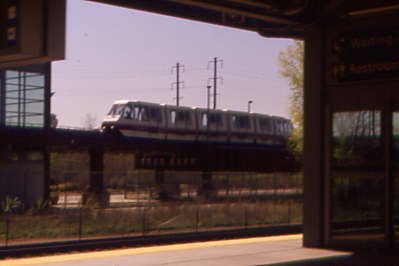
While I was relaxing, we arrived at the Newark Airport station, where I saw their Monorail, the connection from the station to the airport, also arriving. We pulled into New York's Penn Station and I walked the four-and-a-half blocks to the Herald Square Hotel where I checked in and took my bags up to my room.

From there I went back to the front desk to obtain directions to the 32nd and Broadway PATH station.
Port Authority Trans-Hudson (PATH)The Port Authority Trans-Hudson is a 13.8-mile rapid transit system in the northeastern New Jersey cities of Newark, Harrison, Jersey City and Hoboken, as well as Lower and Midtown Manhattan in New York City. It is operated as a wholly-owned subsidiary of the Port Authority of New York and New Jersey. PATH trains run around the clock year-round; four routes serving 13 stations operate during the daytime on weekdays, while two routes operate during weekends, late nights and holidays. It crosses the Hudson River through cast iron tunnels that rest on a bed of silt on the river bottom and operates as a deep-level subway in Manhattan and the Jersey City/Hoboken riverfront; from Grove Street in Jersey City to Newark, trains run in open cuts, at grade level and on elevated track.
I found my way down into the terminal where I purchased a ticket to Hoboken and boarded a waiting train. The route heads south to 23rd Street, then onto 14th and 9th before turning west. We stopped at Christopher Street station and then went under the Hudson River to a junction with the line to Journal Square and the World Trade Center before arriving at Hoboken Terminal.
Hudson-Bergen Light Rail LineOwned by New Jersey Transit and operated by the 21st Century Rail Corporation, it connects the communities of Bayonne, Jersey City, Hoboken, Weehawken, Union City, at the city line with West New York and North Bergen. The system began operating its first segment in April 2000 and expanded over time. The line generally runs parallel to the Hudson River and Upper New York Bay, while its northern end and its western branch travel through the lower Hudson Palisades. The system has 24 stations along a total track length of 17 miles for each of its two tracks.


I boarded car 2027 for the trip to 22nd Street. The train departed at 12:40 PM and after passing the New Jersey Transit rail yard, we came to a junction and turned left. Our route was elevated for a short stretch, giving passengers a great view of the Manhattan skyline. We returned to ground level for Pavonia/Newport then proceeded to Harsimus Cove and I noted that everything we passed was recently built. Harborside Financial Center was the next stop after two hard turns, the first to the left and then to the right. A little "S" curve took us to Exchange Place, followed by Essex Street after a hard right turn then Marin Boulevard after another "S" curve to the right. On the way to Jersey Avenue Station in Jersey City, there was plenty of new construction taking place.
Another "S" curve, this one to the left, followed by a large horseshoe curve, took us to Liberty State Park and just south of here is the junction with the line to West Side Avenue which took off to the right. We stopped to change crews before passing the shops then some fast-running to Richards Street and Danforth Street. We entered Bayonne, stopping at 45th Street, 34th Street and finally 22nd Street, the south end of Hudson-Bergen Light Rail line, where I detrained.

I spoke with the operator before reboarding the car for the trip to Liberty State Park then had a twelve-minute wait for a West Side Avenue trolley that would take me to my next end point. At the junction, we turned right before stopping to change crews then proceeded southwest to Garfield Avenue and between here and Martin Luther King Drive, the line seemed to be a former rail line due to brick work in the cuts. Riding the light rail line is truly the safe way to see this neighbourhood. We crossed over to the other track before arriving at West Side Avenue.

The end of the line at West Side Avenue.

I validated my new ticket and took another picture, but as I did so, the operator blew his horn then waved his finger No! No! No! When I boarded, he said that no pictures were allowed to be taken from New Jersey Transit property, to which I responded that it had been in the press and that George Warrington, the former Amtrak Chief Executive Officer and Head of New Jersey Transit, had rescinded that policy. The operator said no one had bothered to tell him, so I agreed not to take any more pictures on this trip.
I would now return to Hoboken Junction before getting the new mileage to Tonnelle Street. We went all the way back to Hoboken Junction where we turned left onto a new route, ran along the New Jersey Transit yard lead and then under the New Jersey Transit mainline before entering the tunnel under the New Jersey Palisades. This route took us to 2nd Street and we continued along the Palisades to 9th Street before making a big "S" curve to Lincoln Harbor. We climbed up and over a highway that gave a great view of Manhattan then turned west to enter the Weehawken Tunnel under the New Jersey Palisades, which was originally the West Shore Railroad's main line. Inside this tunnel is the Bergen Line Avenue station. At the west end, we returned to daylight and crossed over to arrive at Tonnelle Street station.


The train at Tonnelle Street station. I saw an employee going into the rest station and asked about the NJT photography policy. She went inside to obtain an official answer and a minute later, returned to say that the only place you are not allowed to take pictures is of passengers onboard their train. Stations and everywhere else was fine. I thought I saw a caboose across the street but it turned out to be a building with couplers added.

I returned to the east pedestrian bridge just as my train was exiting the tunnel and coming into the station so boarded this trolley back to Hoboken.

The view across the Hudson River at New York City, minus the Twin Towers which I truly miss.

New Jersey Transit PL42AC 4007 built by Alstom at Hoboken. I walked back to the PATH station.
PATH back to New York City
I boarded a waiting train and a few minutes later, returned to 33rd Street in Manhattan for an hour's rest.
New York Mets Game 4/18/2006As my regular readers know, I have a goal of visiting all the Major League Baseball parks. The Philadelphia Phillies were out of town when I was in Philadelphia, but the Mets were home when I was in New York City. I researched how to get to Shea Stadium and discovered it would be easy. Walk to Penn Station, take Route 1 train one stop to Times Square station where I would transfer to a Route 7 train to Shea Stadium. So that is what I did, but I got lucky. After taking the standing room-only Route 1 train, I went down and boarded a Route 7 express train that made only six stops, so my trip was quicker than expected.
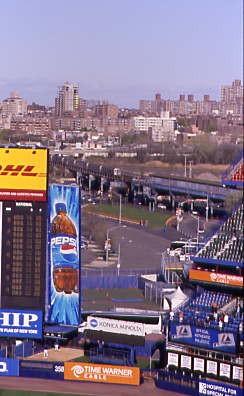
The subway train that brought me to Shea Stadium. I walked the short distance to the stadium where my bag was inspected and I was scanned with a wand then rode the escalator up to Section 1, Row 5, Seat 13.

The view from my seat of the subway station with a train approaching. It was a really windy late afternoon and early evening, so jacket weather for the baseball game. I enjoyed two hot dogs and a Mountain Dew since Shea Stadium serves Pepsi.

Now to the game. The Atlanta Braves scored two runs when Adam LaRoche doubled. In the third inning, Andruw Jones then hit a deep two-run home run to center field. Four pitches later, Adam LaRoche hit a deep shot to right field. In the bottom of that inning, Chris Woodward hit a solo home run for the Mets' only run. In the fifth inning, Andruw Jones hit another two-run home run into the left field stands, ending the scoring for the evening. For the Braves, Kyle Davies pitched a complete game giving up just three hits, one run and walking one.
It was a great game to watch but the Mets fans have the dirtiest mouths that I have ever experienced at a major league ball park and I was glad to be leaving Shea Stadium, returning to Times Square on a subway train that made all twenty stops. I made the easy connection back to Penn Station, which was very lively after the New York Rangers lost their last regular season hockey game to the Ottawa Senators. On my return to the Herald Square Hotel, I stopped off for some postcards before calling it a night.
| RETURN TO THE MAIN PAGE |